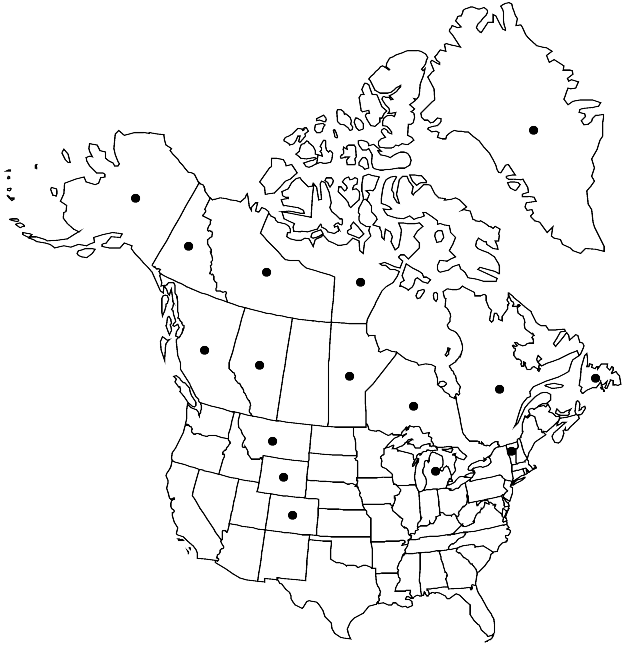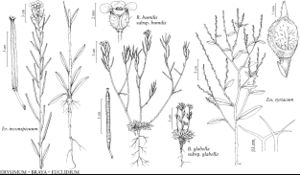Braya humilis
in A. Gray et al., Syn. Fl. N. Amer. 1(1,1): 141. 1895.
Plants not scapose; sparsely to densely pubescent throughout, or, rarely, glabrescent, trichomes short-stalked or subsessile, submalpighiaceous or, rarely, 2-forked, often mixed along petioles and stem base with simple ones. Stems usually few to several from base, rarely simple, ascending or erect, rarely subdecumbent, (0.4–)0.8–2.5(–3.5) dm. Basal leaves: blade obovate, spatulate, oblanceolate, oblong, or sublinear, (0.3–)0.5–2(–3.5) cm × 1–8(–10) mm, base attenuate or cuneate, margins entire, sinuate-dentate, or pinnatifid, apex acute or obtuse, (surfaces sparsely to densely pubescent or, rarely, glabrous). Cauline leaves: 3 or more; blade similar to basal, smaller distally, distalmost sessile or subsessile. (Racemes bracteate proximally, very rarely throughout, elongated in fruit.) Fruiting pedicels erect, ascending, or divaricate, (2.5–)3–8(–12) mm. Flowers: sepals 2–3 × 0.8–1.2 mm, (sometimes slightly saccate basally); petals white, pink, or purple, (broadly obovate or spatulate), 3–5(–8) × (1–)1.5–2.5(–4) mm, (apex rounded); filaments 2–3(–4) mm; anthers oblong, 0.4–0.7mm, (apex apiculate). Fruits linear, torulose or not, (mostly straight), (0.9–)1.2–2.5(–3.2) cm × 0.6–1.8(–2) mm (uniform in width); valves pubescent or, rarely, glabrescent, trichomes submalpighiaceous, rarely mixed with fewer, simple ones; septum fenestrate or not; ovules 20–44 per ovary; style 0.3–0.8(–1) mm; stigma entire or strongly 2–lobed. Seeds uniseriate, oblong, 0.6–0.9× 0.4–0.5 mm.
Distribution

North America, e, c Asia.
Discussion
Subspecies 4 (4 in the flora).
Braya humilis was recognized in Asian floristic accounts as a member of Neotorularia Hedge & J. Léonard (= Torularia O. E. Schulz), but molecular studies (S. I. Warwick et al. 2004) clearly support its assignment to Braya, as done by all North American authors (e.g., M. L. Fernald 1918; E. C. Abbe 1948; T. W. Böcher 1956, 1973; J. G. Harris 1985; R. C. Rollins 1993). The species is highly variable in leaf shape and margin, flower size and color, pubescence, fruit length and orientation, chromosome number, and length of the bracteate portion of the raceme. Occurrence of “races” with various ploidy levels is one of the reasons for variability that led to recognition of infraspecific taxa. The synonymy below pertains only to North America, with nearly as many names given to the Asian variants. Numerous morphological extremes were described in North America, Russia, and China, but most of those represent only part of an otherwise continuous variation. For example, fully bracteate racemes, though rare, appear sporadically in populations that otherwise have racemes only basally bracteate. Three morphological forms are more sharply distinct from the general subsp. humilis amalgam and seem to have some biological significance. All of them are restricted to areas in or near regions believed to have served as glacial refugia during the Pleistocene. They are recognized here as additional subspecies.
Selected References
None.
Lower Taxa
Key
| 1 | Fruits (1-)1.2-1.8(-2) mm wide, not or weakly torulose; stems unbranched, ascending (prostrate in fruit). | Braya humilis subsp. ellesmerensis |
| 1 | Fruits 0.6-1.2(-1.3) mm wide, usually somewhat torulose; stems unbranched or branched, ascending to erect | > 2 |
| 2 | Petals 2.5-6.9(-7.5) mm; fruits usually fertile and fully developed; leaf blade margins often sinuate-dentate, pinnatifid, or entire. | Braya humilis subsp. humilis |
| 2 | Petals (4.4-)4.9-6.9(-7.2) mm; fruits often abortive; leaf blade margins entire or sinuate-dentate, not pinnatifid | > 3 |
| 3 | Leaves and stems glabrescent or moderately pubescent. | Braya humilis subsp. maccallae |
| 3 | Leaves and stems densely pubescent. | Braya humilis subsp. porsildii |
